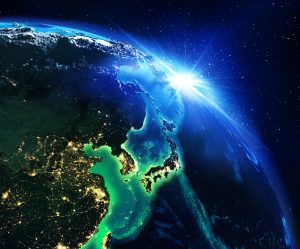Over the past half century, Asia has developed extremely rapidly. Presently, growth is decelerating; Chinese growth, once in double digits, is struggling to reach 4 percent. This could, of course, be a blip in an inexorable upward trajectory, but it could be the first signs that something deeper is amiss. In our just published book, “The Connections World: The Future of Modern Asia” (Cambridge University Press, 2022), we argue that Asia is in indeed facing a watershed moment. We propose a route out of the shallows but show that it requires some difficult policy decisions.
Asia’s development model has differed fundamentally from that taken in earlier times by today’s advanced economies. Two of the most important differences have been the major role played by state industrial policy in orchestrating growth and the reliance on a particular form of corporate structure: the business group. These have allowed Asian economies to concentrate resources on priority areas and have facilitated rapid development.
This model of Asian development is built on pervasive and enduring networks of connections that tie together businesses and politicians. We term this the “Connections World.” At the apex of the system sit politicians and their parties along with these largely family-owned – and often dynastic – business groups. Business groups look to politicians to protect them from competitors as well as provide them with cheap loans, subsidies, and public sector contracts. Politicians look to these groups to support state-led initiatives and provide jobs, especially in politically sensitive regions, as well as for themselves and their families. The relationships between politics and business are thus highly transactional, often with a strong element of reciprocity about them.
Business groups are a format ideally suited to the Connections World. From the politicians’ point of view, business groups provide concentrated points of contact and so reduce complexity in policymaking. It is much easier to guide the economy if a significant share of the economy is controlled by a small number of companies.
The business groups in turn are organized in ways that allow their owners to shift resources around the group, often using transfer pricing or inter-group loans. At the same time, their economic firepower in multiple sectors allow business groups to dominate the numerous markets in which they operate. Our analysis shows that while in the United States, the revenues of the five largest firms amount to no more than 3 percent of the country’s GDP, in China and India, it accounts for 11 percent. This sort of concentration is common throughout Asia.
Perhaps most worryingly, by operating in many markets simultaneously, their scale relative to the economy allows business groups to entrench their market power – not least by leveraging their connections to politicians. This is happening in both Asia’s democracies and autocracies. In probably the most striking case, Samsung, the group recently accounted for 21 percent of South Korean GDP. And even when parts of this world fall out of favor or falter commercially, other connected companies enter.
Among the consequences of the Connections World, the concentration of wealth is particularly striking. In particular, the owners of business groups in emerging Asia have seen an extravagant increase in their wealth over the past 20 years, with the number of billionaires in the continent ballooning from 47 in 2000 to 719 in 2020.
For instance, the number of billionaires in China went from zero in 2002 to 42 in 2008 to 389 in 2020. Their median wealth also grew from $1.5 to $2.1 billion between 2008-2020. In India, the number went from nine to 102 between 2000 and 2020. In a far smaller economy, South Korea, the number of billionaires has also jumped from one in 2000 to 28 in 2020. And increases have occurred right throughout Asia. In China, it seems that this explosion of wealth is now viewed by President Xi Jinping as a potential threat to the political stability of the regime.
The Connections World has thus supported Asia’s extraordinary growth. But problems are mounting. On one plane, Asia’s demographics are increasingly challenging a growth model that has been based primarily on concentrating resources. At the same time, the attenuation of competition that comes with having privileged business groups at its core holds back productivity growth as well as limiting the number of high-quality jobs. Perhaps most significant is the way in which the Connections World stands in the way of Asia shifting to greater reliance on innovation. The politician-business nexus also impedes improvement in institutions and sustains the sort of venal and undesirable relationships that have been exposed in Sri Lanka’s recent meltdown.
In sum, the Connections World is turning from being a driver to a potential drag on Asian growth and development. Even so, it clearly will not disappear of its own accord because all the important players in the game gain from its continuation. It is the rest of the economy – businesses and entrepreneurs unable to compete with business groups, workers unable to get good jobs, and those excluded from income and wealth – who stand to gain from change.
Shifting the balance will require the adoption of policies that will accelerate the disappearance or, more likely, transformation of business groups as well as limiting the discretionary scope for politicians to leverage their business connections. We can learn from how the United States under President Franklin Roosevelt addressed similar problem of business group entrenchment in the 1930s by prohibiting pyramids and related party transactions while enhancing protection of minority shareholders. The impact was augmented by the implementation of strict competition policy including explicitly targeting business groups. Political change must start from greater transparency and the strengthening of civil society, including the application of asset and interest declarations for politicians with more stringent penalties for breaches.
To be very clear: Asia’s further climb up the income ladder has nothing automatic about it. Indeed, a failure to come to grips with the Connections World will impair the brightness of its future.

































